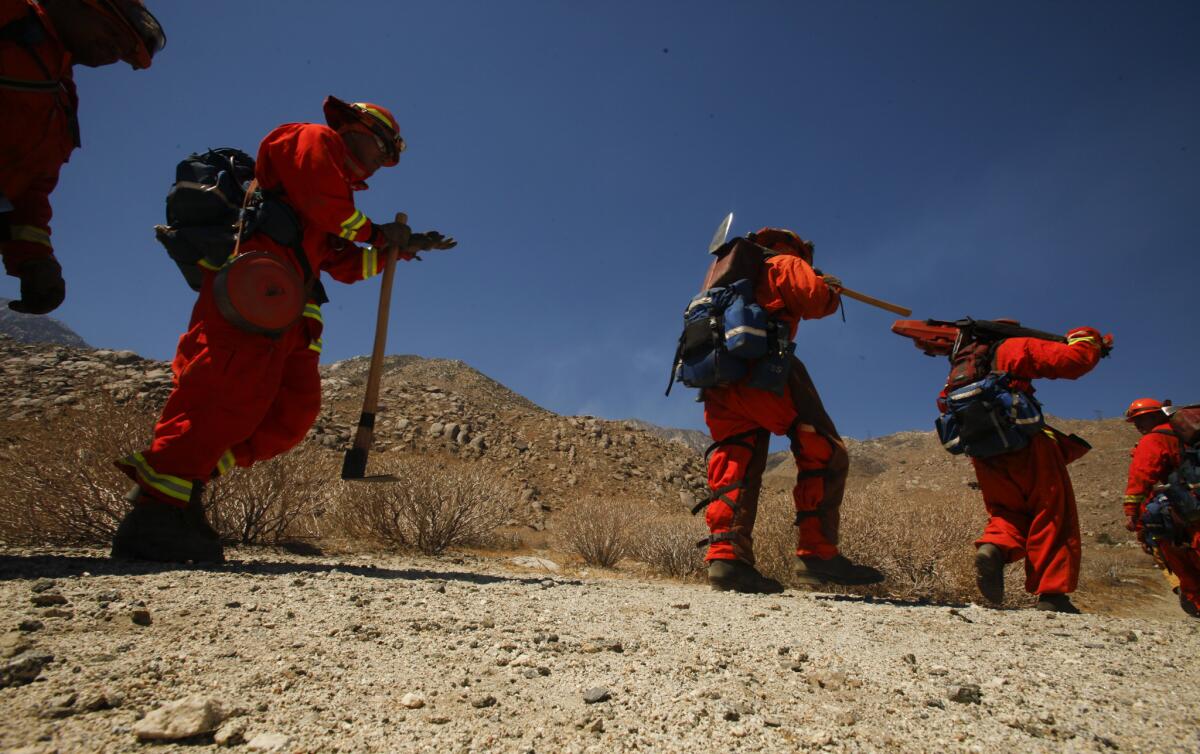Another kind of drought: Inmate fire crews dwindle as wildfire season grows ever longer

- Share via
Already plagued by years of drought and a beetle infestation that has reduced millions of trees to kindling, California is facing yet another problem as it enters the brunt of wildfire season: a dwindling roster of prison inmates who can battle blazes.
The gap is due largely to California’s controversial realignment law, which mandates that inmates convicted of non-serious, nonviolent and non-sexual offenses serve time in county jails rather than in state prisons.
As a result, the pool of eligible firefighting inmates has been shrinking.
“We’ve just had to scramble harder to find inmates we can get,” said Bill Sessa, spokesman for the California Department of Corrections and Rehabilitation. “We still have to be selective about the inmates we choose.”
Traditionally, prison inmates have accounted for at least 20% of the state’s wildfire fighting force and are paid just $2 a day when they’re working but not actually fighting a fire.
Currently, the state has 4,300 budgeted positions for inmates, but only 3,800 to 3,900 have been filled each year since realignment took effect in 2011, Sessa said.
Very nearly all of the California Department of Forestry and Fire Protection teams that dig containment lines around wildfires are made up of prison crews, and in major blazes, they are also called upon to help the U.S. Forest Service.
While the state corrections department has contracted with a dozen counties to pull firefighting inmates from county jails — including those in Los Angeles County — it still hasn’t been able to fill all the vacancies.
In response to the shortfall, Cal Fire and the U.S. Forest Service have turned to the California Conservation Corps.
“In our eyes there’s no difference in the work force,” said Cal Fire spokesman Daniel Berlant. “As realignment continues to be rolled out here, we’re working closely with a number of agencies and thinking outside the box, making sure we have individuals who are in top shape and who are ready to work the fire lines.”
After years of drought and a devastating bark beetle infestation that has killed tens of millions of trees across California, state and federal forests are primed for fast-spreading fires. Crews creating containment lines — for which they use chainsaws and other cutting tools to scrape swaths of land of any vegetation — are “vital” to the effort, Berlant said.
The California Conservation Corps has bodies to offer, albeit at a higher cost.
There are about 1,400 corps members, the overwhelming majority of whom do work that requires little training, like setting up or tearing down a fire camp and rolling up hoses, said corps spokeswoman Susanne Levitsky.
But only a fraction of the group — only 114 last year — are trained in firefighting like the inmates.
“The firefighting is a big sell for the young people who may be pursuing a career,” Levitsky said.
The group’s tongue-in-cheek motto is: “Hard work, low pay … and miserable conditions.”
So far this year, the corps has trained 89 additional members in firefighting and plans to add more over the next two years, she said. The group opened up a camp in Butte County for the first time in years and expects to add more locations by 2018, she said.
“We’re happy to bolster their shortage,” Levitsky said. “It’s a great opportunity for our people.”
But using civilians is also more expensive. A civilian assigned to a fire and working a containment line is paid $10 an hour — the state minimum wage. An inmate with the same assignment is paid $2 an hour. If an inmate is not assigned to a fire, he or she is doing more general preventative work, such as clearing flood channels and hiking paths, Sessa said.
To boost the number of inmate volunteers, the the corrections department is showing prisoners a video highlighting the benefits of the work. Instead of receiving one day off their sentence for every day served in prison, firefighting inmates receive two days’ credit, Sessa said. Though the pay seems miniscule to civilians, it can help inmates pay restitution to a victim, Sessa said.
There are 1,500 new inmates being reviewed for the fire crews, Sessa said. But not everyone who is eligible will be assigned.
“You can have two inmates in prison for the same reason, but you can look at their behavior in prison and say I’m going to pick A but pass on B,” he said.
Inmates ineligible for the program include anyone above “minimum custody” status, violent offenders, documented gang members, inmates with pending felony cases or warrants, inmates with medical, psychiatric or dental issues and inmates with a high profile due to their case or conduct in prison.
The department aims to pick inmates with five or six years left on their sentence to minimize turnover since inmates are assigned until they’ve completed their sentence, Sessa said.
But if all of this isn’t enough to fill the vacancies, Sessa said, there are “internal discussions” taking place on what changes, if any, could be proposed to boost the ranks. The changes would include changing the criteria of the inmates selected, he said.
For breaking California news, follow @JosephSerna on Twitter.
More to Read
Sign up for Essential California
The most important California stories and recommendations in your inbox every morning.
You may occasionally receive promotional content from the Los Angeles Times.










